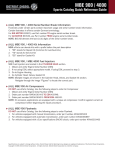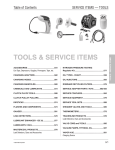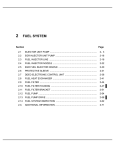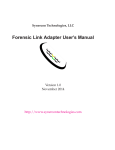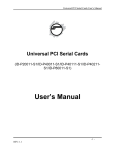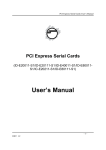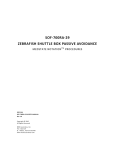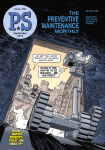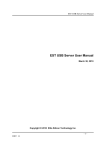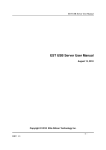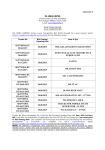Download MBE 4000 Block-to-Cylinder H
Transcript
No.: 09 TS-9Rev December 2, 2009 TO: Service Locations FROM: Technical Support Development SUBJECT: MBE 4000 Block-to-Cylinder Head Joint Repair Information ISSUE Unnecessary replacement of MBE 4000 cylinder blocks. REQUIRED ACTION The attached service information has been developed and released to provide the appropriate information for diagnosing and repairing MBE 4000 cylinder blocks at the cylinder head to block joint. Critical areas of the MBE 4000 block can now be repaired instead of replacing the entire block; cylinder blocks should be repaired using the defined procedures and listed products whenever possible. Refer to this guide when doing block-to-cylinder head joint repairs. Note: In addition to the steps outlined in this document, it is necessary to inspect and verify other components before, during and after the repair to ensure the root cause has been corrected. Refer to the service manual or TS Letter publications for any operations not covered in this document. Refer to the guidelines for reusable parts in the service manual, and e-Parts Catalog for other part number criteria not covered in this document. CONTACT INFORMATION Please contact the Detroit Diesel Customer Support Center at 313-592-5800 or email [email protected] if you have any questions. Detroit Diesel 13400 Outer Drive, West / Detroit, Michigan 48239-4001 MBE 4000 Cylinder Head to Block Joint Repair Information Leak Diagnosis, Cylinder Head and Block Repair 2 CONTENTS 0B DIAGNOSIS ..............................................................................................................................................4 U U Coolant Leaks .......................................................................................................................................4 U U Cylinder Liner Inspection .....................................................................................................................5 U U Oil Leaks ................................................................................................................................................5 U U Counterbore Cracks .............................................................................................................................6 U U REPLACEMENT PARTS ........................................................................................................................7 U U Cylinder Heads .....................................................................................................................................7 U U Cylinder Head Gaskets ........................................................................................................................8 U U CYLINDER HEAD AND BLOCK REPAIR RECOMMENDATIONS ...................................................9 U U APPENDIX A – REMAN CYLINDER HEAD ACCEPTANCE CRITERIA ........................................10 U U APPENDIX B – LINER HEIGHT MEASUREMENT SHEET .............................................................12 U U APPENDIX C – REFERENCE MATERIAL .........................................................................................13 U U 3 light). It is not necessary to change the coolant after adding the dye. DIAGNOSIS 1B Another area that is misdiagnosed for a leaking head gasket is water (not coolant) seeping from the head gasket vent hole. Any water over the top of the engine drains along the block edge towards the back of the block. As the water passes by the vent hole, a capillary action sucks the water in and drains the water out with the change in engine temperature. This is evident by the rust found near the vent hole side during teardown inspections. See Figure 2. Coolant Leaks 8B It is vital that common practice methods like pressurizing the coolant are used first to assist in determining the root origin of coolant leaks. Consider the length of time in service and prior repair history as a guideline for where to look for coolant loss. Typically, the less time a unit has been in service, the more minor the correction will be while the factors for coolant leaks from high mileage units may be corrosion, deterioration, or lack of cooling system maintenance. X X Vent Hole The coolant vent line is often misdiagnosed as a head gasket leak. The coolant vent line is attached to the center top of each cylinder head and is very difficult to see behind the EGR cooler and EGR cooler bracket. However, any leakage from this coolant vent line will show near the head to block joint and down the side of the block. See Figure 1. X X Figure 2. Head gasket vent hole witness marks Engines built after Serial Number 0460896913 have head gaskets without a vent hole to address this concern. Note: Water draining from the truck’s windshield rain tray may also contribute to this situation. Rain tray leaks will generally leave a rusty streak since it is plain water. Head gasket leaks are less rusty in appearance and will generally appear just wet. Rain tray leaks are usually location specific on the engine. Columbia/Century/etc will have rusty streaks between cylinders 5/6 because the rain tray hole is directly above that joint between the cylinders. In Sterling car haulers, the rusty streaks will be up around either cylinders 1/2 or 2/3 because the engine is set farther under the cab in that application. Reference Freightliner bulletin 60-140 and Sterling bulletin 60-21 for more info on plugging the rain tray hole. See Figure 3. Figure 1. Typically any leaks from a properly maintained coolant system will show up as the coolant color or white ash if dry A product that has been very successful in assisting to find the origin of a coolant leak is tracer dye. Tracerline® offers Dye-Lite® TP-3900 Fluorescent Leak Detection Dye for Coolant Systems. Kits are available with dye and a black light. Information and local source of this product can be found at www.tracerline.com. Follow the manufacturer’s instructions when using this product (1 oz to 6 gal of coolant, bring the engine to operating temperature, shutdown the engine, look for dye traces with a black X 4 X around and under the liner flange. With the release of a new liner, o-ring seal, and counterbore cutting tool, this concern is completely repairable; reference 08 TS-8Rev for complete details on performing this repair. See Figure 5. U U X X Rain Tray Hole (plugged) Figure 3. Plugging the rain tray drain hole may reduce water draining on top of engine X Cylinder head cracks and cup plug leaks will also show up as coolant leak witness marks on the sides of the engine block. Follow the service manual procedure for pressure checking cylinder heads to validate the heads if suspect leaking is found. See Figure 4. Figure 5. Fretting around cylinder liner from high mileage X Oil Leaks 10B Oil leaks that occur above the head to block joint may appear to be problems at this joint, but are really not. Tracerline® offers Dye-Lite® TP-3400 to assist in finding the origin of oil leakage. This product is similar to the product used for coolant, but is specially formulated for oil. Follow the manufacturer’s instruction when using any of these products. Information and local source of this product can be found at www.tracerline.com. Rocker cover gasket leaks are the predominate source of oil leaks. See Figure 6. This leak will typically be heavy staining of the sides of the block and allow dirt to stick. Normal inspection is made difficult by most of the sealing surfaces being hidden behind other components. Rocker cover gaskets are reusable, therefore tightening of the rocker cover hold down bolts may be the only service required. X Figure 4. Leaking cylinder head cup plug Typically the rear of the cylinder head and the rear cup plug have been more prone to cracks and leaks due to being on the exhaust side and exposed to higher temperatures. Cylinder Liner Inspection 9B Units with considerable miles or severe duty cycles may have liners that have loosened in the bore. This condition may be evident by erosion and fretting 5 X Slight Rocker Cover Oil Leak Figure 6. Rocker cover oil leak Figure 8. Cracking around counterbore circumference 2B The Constant Throttle Valve line is another possible source of oil leaks to consider. The CTV line is hidden behind the EGR cooler and EGR cooler brackets, there is a connection on the exhaust face of each head and will leave oil traces down the side of the block. See Figure 7. X X Figure 7. Oil traces from leaking CTV line 1B Counterbore Cracks Counterbore cracking is primarily caused from thermal and stress relief of the cylinder block; however, these circumferential cracks have no influence on the sealing area and are acceptable for engine overhaul. See Figure 8. Any erosion of the counterbore can usually be cleaned up with a light cutting. Liner heights are the most important dimension to be maintained for proper sealing. Shim thickness must match the cut depth to ensure the appropriate liner height. X X 6 The remanufactured cylinder head has a raised bead ring around the combustion seal surface area. There will be a gap if a straight edge is placed over this deck as well. See Figure 11. REPLACEMENT PARTS 3B X X Cylinder Heads 12B Part numbers for the different cylinder heads can be found in technical service letter 09 TS-11. U U There are three types of fire decks: 1) a very old flat fire deck with no heat treat in the combustion seal area and no recess in the coolant and oil grommet area – see Figure 9, 2) a heat treated original equipment fire deck cylinder head with flat grommet sealing areas, and 3) a heat treated original equipment fire deck cylinder head with recessed grommet sealing areas - see Figure 10. This style has four crescent shaped raised sections around the combustion seal. These raised areas are done by design and should not be confused or misunderstood for deck warping. X X X X Figure 11. Raised section of combustion sealing area There are also heads with two cup plugs and heads with one cup plug and one solid plug. See Figure 12 and Figure 13. X X X Figure 9. Cylinder head with no recess around oil and coolant grommet areas Figure 12. Cylinder head with cup plug Heat Treat Area Figure 10. Head with heat treated combustion area and recessed grommet area Figure 13. Cylinder head with solid plug 7 X Cleaning of the cylinder head fire deck should only be done by hand with flat scotch-brite pads and oil or diesel fuel to avoid altering the heat treated or machined surface around the combustion seal area. Power tool scotch-brite pads are not recommended as they may remove metal which could distort these details. Reference 01 TS-38 Letter. U U See Appendix A for Reman cylinder head acceptance criteria. Cylinder Head Gaskets 13B Four different head gaskets have been used over the last several years: 1) flat grommet without vent, 2) flat grommet with vent, 3) raised grommet without vent, and 4) raised grommet with vent. The last design that is recommended to be used is the closed vent gasket that matches the flat or recessed grommet hole in the cylinder head. Figure 14 shows the closed vent gasket, Figure 15 shows the open vent head gasket, while Figure 16 shows the flat grommet and Figure 17 shows the raised grommet. X X X Figure 16. Gasket with flat grommet X X X X X Figure 17. Gasket with raised grommet Interchangeability: Figure 14. Closed vent head gasket Inspection of these parts must happen just prior to the time of assembly to ensure the proper gasket is used with the cylinder head. It is possible to have different heads on the same engine, for example, if a remanufactured service head was used to replace a single head on a prior repair. Note: The head gasket must match the grommet area of the cylinder head! Cylinder heads machined with recessed sealing areas require a raised grommet style head gasket, while a flat cylinder head requires a flat grommet style head gasket. Figure 15. Open vent head gasket 8 CYLINDER HEAD AND BLOCK REPAIR RECOMMENDATIONS 4B The next step is to stuff shop towels into the push rod holes such that the towel is below the surface but can later be removed with needle nose pliers. This will keep any debris from contamination the cam and cam followers. Units with cylinder head to cylinder block leakage concerns are now repairable. In most cases, there is no longer any reason to replace engine assemblies. Note: Remove towels from cylinder block after surface refinishing is complete. The sealing areas are: 1) the compression seal around the liner, 2) the two coolant holes that are sealed with grommets, and 3) the two oil holes that are sealed with grommets. See Figure 18. X 3M Roloc Bristle Discs are recommended to remove carbon and surface rust. These discs come in three levels of abrasiveness: green (50 grit), yellow (80 grit), and white (120 grit) for different purposes. See Figure 20. X X Figure 18. Critical head sealing areas Figure 20. 3M Roloc Bristle Disc 2", used for cleaning mating surfaces These five areas are the most important to maintain and qualify to ensure a quality repair. The liner height is set by the counterbore cut and sets the proper crush for sealing the combustion chamber as well as the other grommets. For high mileage units, the recommendation is to set the liner heights to the lower half of the specification, this will allow for minor surface imperfection while applying maximum crush on the grommets. Reference 08 TS-8Rev. U Severe areas may require tapping or chipping, but you must stay away from the grommet sealing areas. These areas will typically be the cleanest because they were protected by the grommets and as long as there is no area higher than the grommet sealing areas, everything should seal properly. Pitted surfaces that are not in a sealing or grommet area should not be a problem, but they do look bad and if in question or they are in a sealing area there are epoxy products recommended to repair these areas. See Figure 21. U If the block surface has become eroded, a quality repair can still be achieved. The recommendation is to remove the liners and the dowel pins before attempting to clean the block deck. Using a collet type dowel puller will make the job easier. See Figure 19. X X X X Figure 19. Collet type dowel puller 9 X and fine emery cloth, or by draw filing. See Figure 23. Minimum to no metal removal is the goal. X X Figure 21. Repairable block surface using Devcon Titanium Putty 10760 Figure 23. Draw filing the block deck to obtain a perfect sealing surface Devcon® Titanium Putty 10760 with cleaner is a recommended epoxy for filling in pitting. Also ® Belzona 11311 Ceramic R-Metal is considered an industry standard. Follow the manufacturer’s instruction when using these products. It is always better to use these products sparingly to minimize the removal of excess material. These epoxies can also be used to fill-in pitting found on the seat of the counterbore. The sides of the counterbore have minimal effect and should not be a concern if pitting is found there. See Figure 22. Contact information for the epoxy can be found at www.devcon.com and www.belzona.com. X After prepping the block deck and during the liner height measurements, you can use the same tools to qualify the surfaces at the grommet areas. See Figure 24. The areas around the grommets should be within 0.012 mm (0.0005”) of the block deck. Appendix B is a Liner Height Data Sheet. X X X Figure 24. Measuring cylinder liner protrusion Remember to check the alignment of the cylinder heads to each other to avoid exhaust manifold gasket failure. Use the proper alignment tool to set the cylinder heads, apply a light torque and recheck to ensure the heads have not moved. Figure 22. Sidewall pitting is not critical After making epoxy repairs to the block surface, lightly finish the top deck by using a stone, a block 5B 10 APPENDIX A – REMAN CYLINDER HEAD ACCEPTANCE CRITERIA Small indications around the induction hardened areas are normal and ARE ACCEPTABLE. Small indications in a circular pattern around the combustion chamber are normal and ARE ACCEPTABLE. Indications that are NOT ACCEPTABLE include: • Any crack that radiates outward from a bolt hole, valve or passage • Any crack that radiates towards the edge of the head • Any crank that radiates from the edge of the head • Any crack between valves, bolt holes or passages 11 09 TS-9Rev - 12 - APPENDIX B – LINER HEIGHT MEASUREMENT SHEET 6B 12/2/2009 09 TS-9Rev - 13 - 12/2/2009 APPENDIX C – REFERENCE MATERIAL 7B (Dated Material as of 11-25-09) w www.ddcsn.com MBE 4000 Service Manual Section 1.3 Cylinder Head Section 1.4 Cylinder Block MBE 4000 Service Information Cylinder Block Liner Service Procedure Cylinder Block Liner Service Procedure Cylinder Head Bolts Tightening Stages CONTACT INFORMATION 08 MBE 4000-1 REV (EPA04) 08 MBE 4000-1 REV (EPA07) 07 EPA04 MBE 4000-6 U U U Technical Service Letter Please contact MBE the Detroit Customer does notDiesel recommend the useSupport of Scotch Center at 313-592-5800 or email [email protected] if you have any questions. Brite Pads or Sandpaper during engine repairs MBE 4000 Cylinder Head and Gasket Sealing Area Inspection 01 TS–38 U 05 TS–38 U MBE 4000 Coolant Leaks MBE 4000 Cylinder Head and Head Gasket Information 08 TS–8Rev U 09 TS–11 U www www.3m.com Roloc Bristle Discs Surface Conditioning www.tracerline.com Hwww.tr Dye-Lite TP-3900 Fluorescent Leak Detection Dye-Lite TP-3400 Fluorescent Leak Detection Coolant Oil Hwww. www.devcon.com Devcon Titanium Putty #10760 Epoxy Surface Repair Hwwwwww www.belzona.com Belzona 11311 Ceramic R-Metal Epoxy Surface Repair















